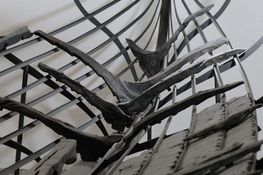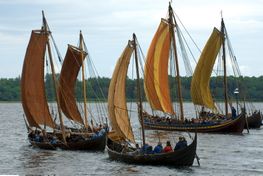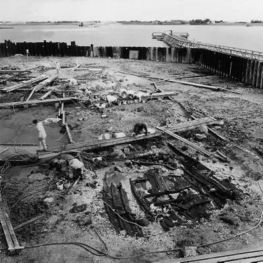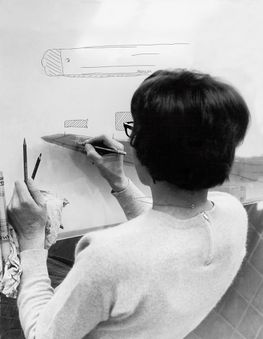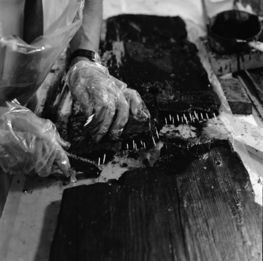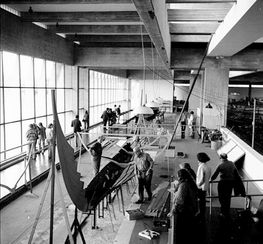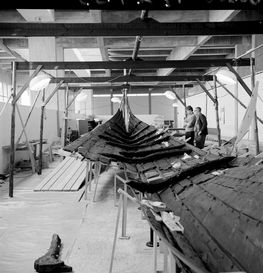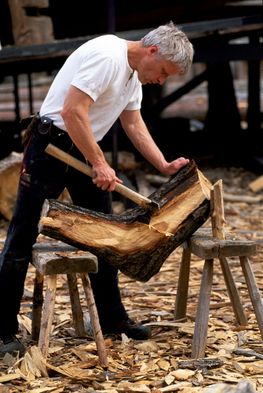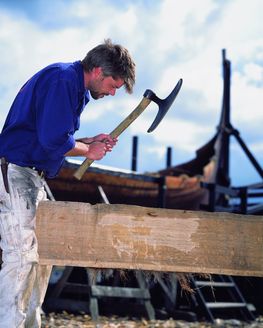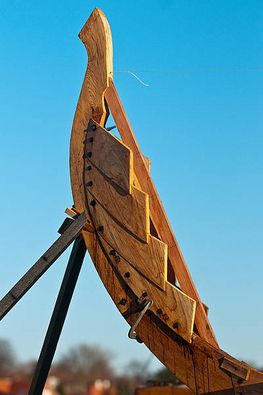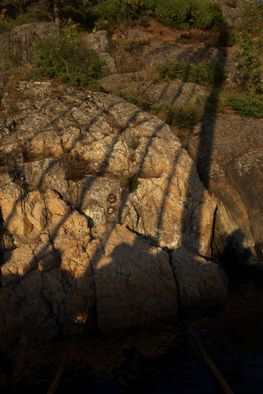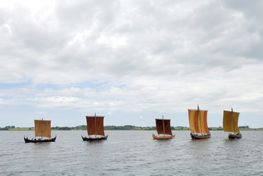Armchair comments
The Skuldelev find encompasses not just five ships, but also five ship-types that turned our knowledge of maritime culture in the Viking Age upside down.
Together these ships provide a multi-facetted impression of Viking-Age shipbuilding, navigation, trade, defence and warfare.
On the occasion of the 50th anniversary of the excavation of the Skuldelev ships we have asked several experts in Viking history, archaeology and navigation the question:
"What have the Skuldelev ship-find contributed to our knowledge of the Viking Age?"
Read their answers here:
- Arne Emil Christensen, Archaeologist and Former Director of the Viking Ship Museum in Oslo, Norway
- Claus von Carnap-Bornheim, Prof. Dr., Director of Archäologisches Landesmuseum, Schloss-Gottorf in Schleswig, Germany
- Else Roesdahl, Professor of Medieval Archaeology, Aarhus University
- Jerzy Litwin, Director, Polish Maritime Museum in Gdańsk, Poland
- Niels Lund, Prof. Dr. Phil, History, Saxo Institute, University of Copenhagen
Anton Englert, Ph.D in Archaeology, Curator and Research Coordinator, Viking Ship Museum
The Skuldelev ships are a key find for understanding transportation needs and vessel specialization in the late Viking Age. Luckily for us, ships representing two construction methods (in hardwood and softwood), three areas of origin (Denmark, Norway and Ireland), and five different transportation types (fishing and other daily trips, short and long trading voyages, local defence and the projection of regional power) were sunk in the Skuldelev barrage. The five ships are evidence of an internationally oriented society that had begun to be divided into fishermen, farmers, craftsmen, merchants and landowners or nobility – a division that characterises the late Danish Medieval kingdom with Roskilde as an important secular and ecclesiastical centre.
Arne Emil Christensen, Archaeologist and Former Director of the Viking Ship Museum in Oslo, Norway
Before the excavation of the Skuldelev ships, our understanding of Viking ship came from the three Norwegian ships from Oseberg, Gokstad and Tune. These are all from early the Viking Age and seem to represent the same ship-type, presumably a universal ship-type used for warfare, trade of small luxury goods or colonising voyages to the North Sea islands and Iceland. With the Skuldelev find we were given ships from the late Viking Age that are examples of several ship-types for more specialized activities like trading or warfare. That was the immediate result. The fact that the ships were given their own museum, around which a large and diverse organisation has eventually developed, has led to positive effects on many levels. Here it is appropriate to highlight the work of Ole Crumlin-Pedersen. Not just his own research, but what we can call the foundation of his scientific research.
Research carried out for 50 years with ‘the replicating experiment’ as a vital innovation has given us new concrete knowledge of Viking Age boatbuilding, sail-making and navigation and has laid the foundation for many new theories about Viking Age society. Meanwhile, dissemination has passed on new knowledge to a long line of people. The first 50 years have placed the Skuldelev ships and the Viking Ship Museum at the top of the list of innovative research institutions. I have no doubt that the ships and the environment surrounding them will continue to contribute new knowledge the next 50 years.
Claus von Carnap-Bornheim, Prof. Dr., Director of Archäologisches Landesmuseum, Schloss-Gottorf in Schleswig, Germany
There is no doubt: Ships are the queens of prehistoric archaeology in Scandinavia and the rest of the world.
Why? The statement potential of shipwrecks is enormous. We observe technical excellence, social interaction and the efficient conquest of the sea as a landscape otherwise closed to humans because of their biology. However, this potential can only be exploited when treated with scientific and museum resources. And here the latest part of the story of the Skuldelev ships is pioneering because the Viking Ship Museum succeeded in processing the find in a very pragmatic manner. Here the wrecks have been explored and presented in an excellent way. The museum in Roskilde has chosen a very special and unique approach.
The Viking Ship Museum links research to the object itself through experimental archaeology, especially with spectacular full-scale reconstructions. The work with these vessels is at the same time considered a mean of preserving cultural heritage ranging from the Viking Age to the present, that is to say, from ‘Sea Stallion’ to a fibreglass sailboat. This is a unique contribution to European research culture, and thus the ships from Skuldelev are not only essential for interpreting of the Viking Age, but also for the common cultural heritage of Northern Europe and the world.
Else Roesdahl, Professor of Medieval Archaeology, Aarhus University
The Skuldelev ships gave us five different Viking ships each with their own fascinating story. They also gave us a museum where the ships are visible and workshops where you can come close to the technology. There are copies of all the ships so that one can experience sailing with ships from the Viking Age and at the same time obtain specific knowledge about their sailing capabilities.
They gave a beautiful breath of fresh air to the Viking Age.
The Skuldelev ships were the starting point of a vibrant, world-class maritime archaeology research centre that has progressively expanded to cover prehistory and the Middle Ages and has provided assistance to many projects around the world. Here was an unusual symbiosis between research, practice and experimental archaeology, which again gave inspiration to maritime archaeology research, education and dissemination around the world. That the Skuldelev ships were scuttled to create a barrage to defend Roskilde became an important side effect that motivated new interest in this kind of military installation.
The Skuldelev ships were excavated at a time when general interest in the Viking Age was growing and the find contributed to this. The five ships were found to be built in very different locations: in Denmark, in western Norway and in Ireland. The extensive research surrounding them provided a completely new insight into the Viking Age – its warfare, trade, travels, technology, resources, dynamics and international relations. The Skuldelev ships and ships in general were integrated into the period in new ways. A distinguished line of scientific publications explained the research’s foundation and was followed by all types of dissemination.
The Skuldelev ships have become a part of Danish cultural heritage. The name Ole Crumlin-Pedersen is inherent in them, and with the development of maritime archaeology and the Viking Ship Museum in Roskilde.
Now new generations have taken over and this year the Viking Ship Museum turns 50. Warm congratulations and best of wishes for the future!
Jerzy Litwin, Director, Polish Maritime Museum in Gdańsk, Poland
The discovery and successful exploration of a wreck site near Skuldelev, where five Viking Age ships were found, as well as the subsequent research, conservation and exhibition of the ships, gave shipping historians and museum specialists an incentive for important activities, not only in Denmark but in many other countries. The most valuable result was, without a doubt, expanding the knowledge of shipbuilding and shipping of the late Viking Age.
Another source of inspiration for museum specialists and shipping historians was the rapid development of the ‘Vikingeskibshallen’ in Roskilde, a branch of the National Museum in Copenhagen. Thanks to comprehensive studies of ancient shipbuilding (including non-European techniques) led by an outstanding expert on the subject, Ole Crumlin-Pedersen, this institution, although seemingly limited by its specialization, soon became a world leading centre for research in shipbuilding history and experimental archaeology. Results of these studies were published internationally and inspired scholars in many countries to make an effort and follow this example. Another area where Roskilde became an important centre was the development of experimental archaeology. Building reconstructions of all the Skuldelev ships, with the help of significant number of volunteers, was not only an excellent promotional effort, but also a means of broadening knowledge of shipbuilding and shipping in the Viking Age.
Based on major accomplishment in the Viking Ship Museum’s first 30 years and with funding provided by the Danish National Research Foundation, the Centre for Maritime Archaeology and the Institute of Maritime Archaeology at the National Museum were created. Between 1993 -2003 activities from these two institutions was fruitful. Today, when looking in retrospect, one can safely say that for Denmark it was the “golden age” for developing studies of shipbuilding history and shipping. We also know that many scholars from different countries look back on the hospitality experienced during their visits at Roskilde’s research facilities. The knowledge acquired there was taken back home and influenced the development of maritime archaeology and the knowledge of its main object – wreck of an ancient ship – worldwide.
The discovery of the Skuldelev ships and the activities of the first director of the Viking Ship Museum, Ole Crumlin-Pedersen were appreciated and - as much as possible at the time - followed in Poland. In 1964 this scholar, already an authority on Viking Age shipbuilding, visited Poland and evaluated wrecks found in 1933-34, establishing their Slavonic provenance. In the light of repeated claims of their Nordic or German origins, made since their discovery it was an important statement. It is today an undisputed fact that the wrecks, dated for 9-13th centuries, discovered along the southern coast of the Baltic, from Hedeby to Gdańsk, are remains of Slavonic boats.
In the span of the last 40 years specialists from the Polish Maritime Museum, particularly those interested in studying shipbuilding, often visited Roskilde - not only for conferences and seminars but for longer study- periods at this institution. Several employees of the Polish Maritime Museum (including the author of this text) have conducted studies at this renowned institution, invited by directors of the Viking Ship Museum, and thanks to the Danish government fundings. These visits contributed to personal development of the employees as well as development of Polish maritime museology, especially within the fields of maritime archaeology and conservation of artefacts retrieved from a wet environment.
Activities at the Viking Ship Museum were an example of inspiration for the Polish Maritime Museum when creating the Polish Museum of Maritime Archaeology in Puck (a town by the Gdańsk Bay). At Puck several Viking Age wrecks have been discovered, including one showing a mix of two shipbuilding techniques – Slavonic and Scandinavian. The wreck, named P-2, constitutes a proof of contacts between the two schools in Viking times.
Today, when Ole Crumlin-Pedersen is no longer with us and the two centres of ancient shipbuilding studies have been closed, it is expected that the Master’s pupils will continue to expand the Viking Ship Museum - especially that more wrecks, including those discovered during the construction of the museum harbour, awaits reconstruction. Scientific studies of these wrecks will no doubt broaden our knowledge of Mediaeval shipbuilding and demonstrate the necessity of further expanding of the Viking Ship Museum – the institution created for the Skuldelev ships.
Niels Lund, Prof. Dr. Phil, History, Saxo Institute, University of Copenhagen
More than 50 years ago, when I began to study the Viking Age, one learned that there was a universal type of Viking ship: the Gokstad ship. With the Skuldelev find we were suddenly presented with different types for different purposes: large and small trading ships, large and small warships, and maybe a fishing boat or a ferry.
That meant that we had to reconsider claims as to why the Vikings one day acted as peaceful merchants and the next day as pirates. Ships like Skuldelev 2 and Skuldelev 5 were not been to transport a lot of goods to sell far from home, and ships like Skuldelev 1 and Skuldelev 3 were not sailed up the river Seine to go plunder Paris or sailed to Lindisfarne to trample relics or steal the gold monks used to decorate their fine manuscripts.
Dendro-dating proved that the Skuldelev ships mainly illustrate vessels of the 11th century; we do not have similar discoveries of ships used for daily purposes from the 9th or 10th centuries. That is, however, absence of evidence, not evidence of absence.
